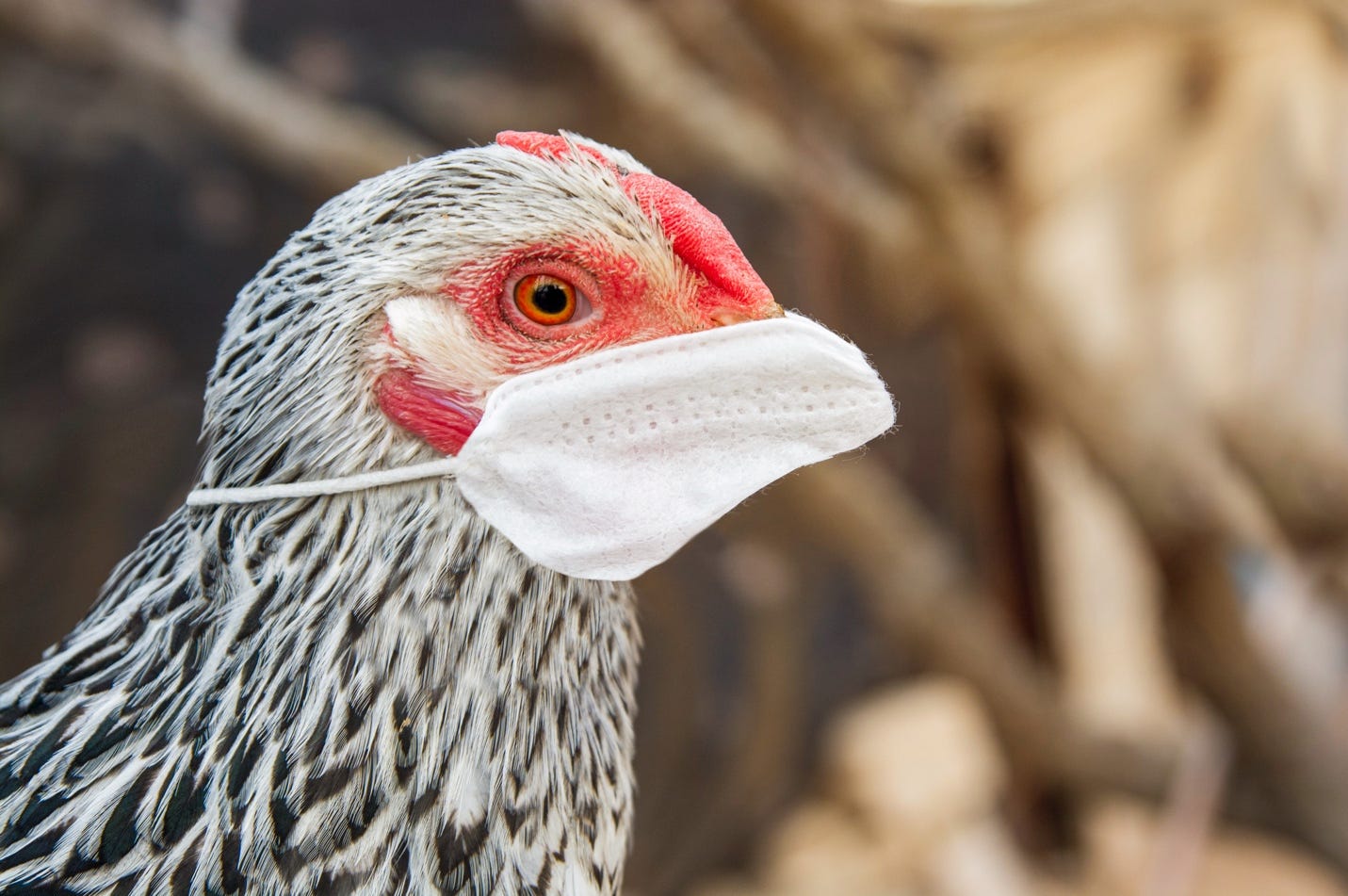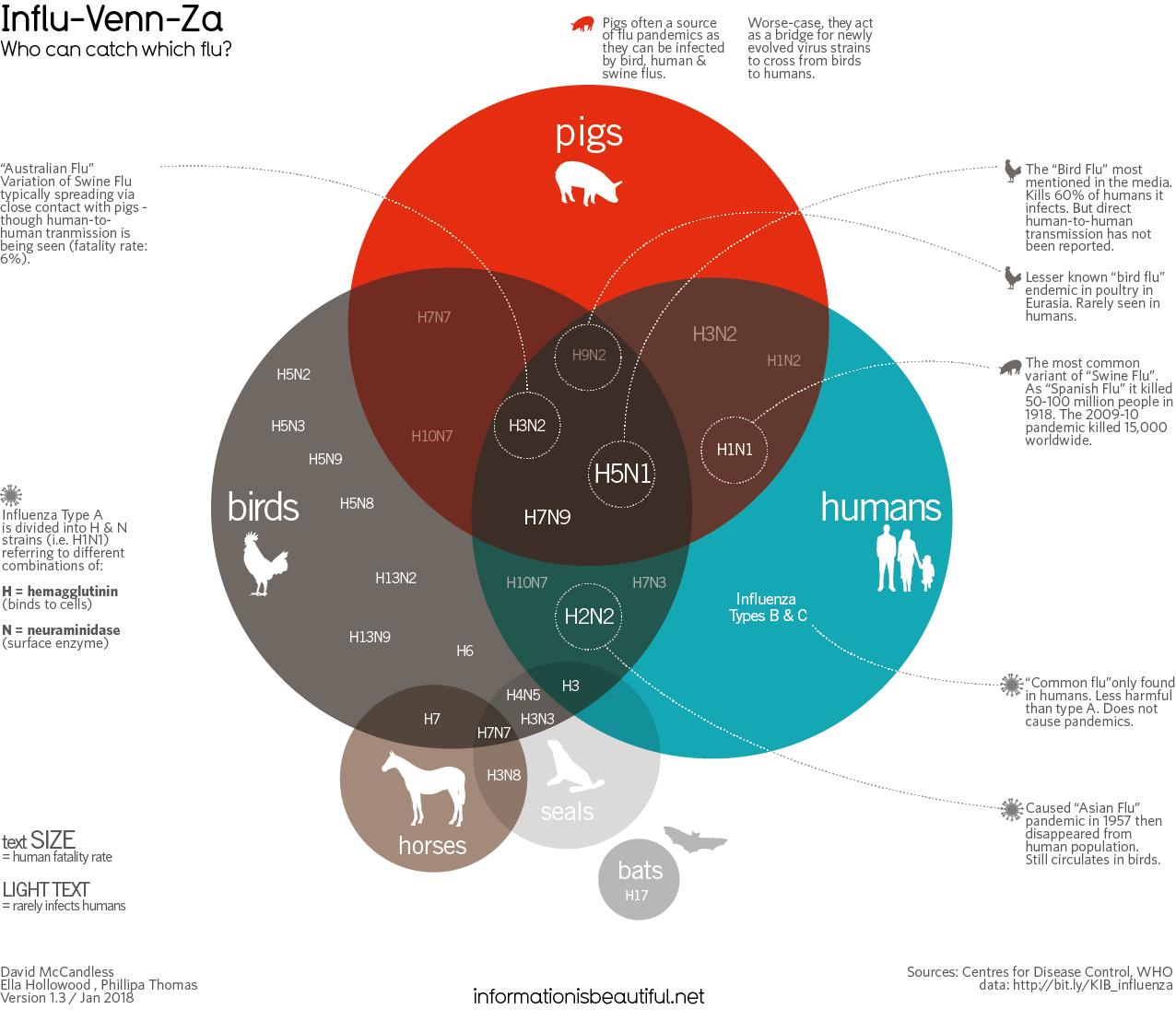
I don’t know about you but when the last pandemic swept the globe, I got the distinct impression that beyond my family, nobody cared much about my health. Here in Iowa, masks were panned and mask mandates were banned. The unfortunate were ordered back to work. With that in mind, I decided to brush off my notes from the last round of bird flu and give them an update just in case this hits the fan.
Perhaps you recall your biology and remember that a virus can’t reproduce on its own. It needs a host which was why lockdowns and masks were recommended during COVID.
Bird flu, H5N1, is an Influenza A (A as in Avian).
According to the CDC, Influenza A viruses are divided into subtypes based on two proteins on the surface of the virus: hemagglutinin (H) and neuraminidase (N). These are parts of the virus (which has a protein coat) that are easily identifiable—like IDing a perpetrator. If you want to read more about that here is a great description. Let’s just say that it takes a matchup of the right H and N to allow a virus to invade your cells, hijack them, create “baby” viruses, and pop the cells to release more viruses. That is how we get the designations such as H1H1 (the deadly Swine flu) and H2N3 (another virulent strain.) Both of these, and all influenzas, are zoonoses–infections that can move between people and animals.
Viruses reproduce by injecting themselves into cells and replacing cellular RNA with their own. Influenza A, the type deadly to humans, has eight strands of RNA bundled together to give our poor cells a big punch.
Here is an old diagram showing Influenza A and the animals it traditionally infects. Note that H5N1is deadly to humans.

I’d like to thank https://informationisbeautiful.net/licensing for letting me use this for free because fewer than 100,000 people visit me here.
Many Type A viruses can creep between birds, humans, pigs, and now dairy cows. Birds are a significant reservoir of these viruses. Shore birds including geese are potent carriers, but other types of domestic and wild birds also carry viruses. For example, N3 viruses are associated with ducks.
Most Influenza A viruses originate in birds. However, not many of these are easily transmitted to people. They can be transmitted to pigs. Pigs are a common go-between for viruses. It’s known that pigs act as mixing vessels for bird flu which is hard for people to catch and pig flu which people can catch. They create new types of flu inside them–possibly in their snouts/respiratory tracts. There are several other diseases that can be transmitted between pigs and people. Pigs and humans can infect each other with influenza more easily than birds and humans can infect each other. Pig flu symptoms are much like human flu symptoms.
Iowa is home to about 24 million hogs, with the number of hogs per farm on an ever-uphill climb. Iowa also has over 60 million chickens. What could go wrong?
We can’t directly blame the chickens. Domestic pigs get wild bird viruses when birds interact with water used for cleaning their housing facilities that sits on site in ponds. In my opinion, deregulation of such facilities is asking for a new flu to be created.
A new wrinkle is that the Influenza A virus is now being detected in dairy cows and cats. Dairy farms in Texas noticed that the cows were producing less milk, and thick milk, and all of the farm cats died. The cats are thought to have eaten infected birds or more likely unpasteurized milk. H5N1 has also been found in marine mammals and foxes.
A few people have gotten it, probably from air born particles laden with virus. Although the most recently infected person got a mild case from a cow, over half of humans infected with H5N1 die of respiratory illness. The good news is, it isn’t transmitted from one human to another, at least not yet. The main worry is that a mutation will allow this.
It is suspected that ground up chicken waste may have introduced the flu virus into dairy cattle. Did you know that dairy cattle in the US are fed “poultry litter” – a mix of poultry excreta, spilled feed, feathers, and other waste scraped from the floors of industrial chicken and turkey production plants? I sure didn’t! Besides being found in cattle and cats, this new bird flu breaks the global flu pattern where influenzas originate in Asia.
Now, Iowa will be welcoming even more cows to the state. And besides eating a diet of chicken scraps, dairy cattle are often shipped across the country, posing more of a threat of the spread of bird flu.
I’m remaining cautiously optimistic that once spring migration of wild birds is over, this flu will die down. I really don’t want to run on a wing and a prayer like we did during COVID. In the meantime, there are a few ways to get ahead of this potential pandemic.
1. Cook eggs thoroughly. Make sure any chicken is cooked to an internal temperature of 165 degrees. The virus will denature and fall apart.
2. Don’t let raw meat touch surfaces in your kitchen. Cook beef to at least 145 degrees. (Note: bird flu has not been found in non-dairy herds.)
3. If cats can get the virus from unpasteurized milk, maybe you could too. Best avoid it. (Pasteurized milk has been found to contain virus particles.)
4. Move to California. Buy California products. California regulates the use of bird litter as food.
5. If you use manure as fertilizer and it isn’t from a bag that reads “composted”, compost it. Please don’t use raw manure. It can burn plants and introduce pathogens.
6. Wash hands and clothing after touching birds. You should also wear a facemask.
7. Hunters should field dress birds while wearing protective equipment.
8. Take an antiviral medication if you are sick after contact with infected animals. Bird flu symptoms in humans are similar to other flu symptoms: fever, fatigue, sore throat, muscle aches, vomiting, diarrhea, stuffy nose.
9. Other states have taken steps such as killing infected birds and limiting cattle shipments.
10. If you have pet birds, keep them in a covered location away from wild birds and wild bird droppings. Know the symptoms of bird flu: sudden death, nasal discharge, low appetite, limited egg production, soft or misshaped eggs, diarrhea, and un-coordination. It’s wild bird migration season so keep flocks inside and covered up.
The Secretary of Agriculture, Tom Vilsack, points out that cattle appear to be recovering from bird flu quite quickly. And no one has yet to become sick from consuming contaminated foods, at least as far as we know. Vaccines for cattle and humans (although we might not have enough) are being developed.
No doubt if COVID had affected farm animals, our governor might have taken it more seriously. She really was a dumb-dumb when it came to that virus. Or should I use the term bird brain?

